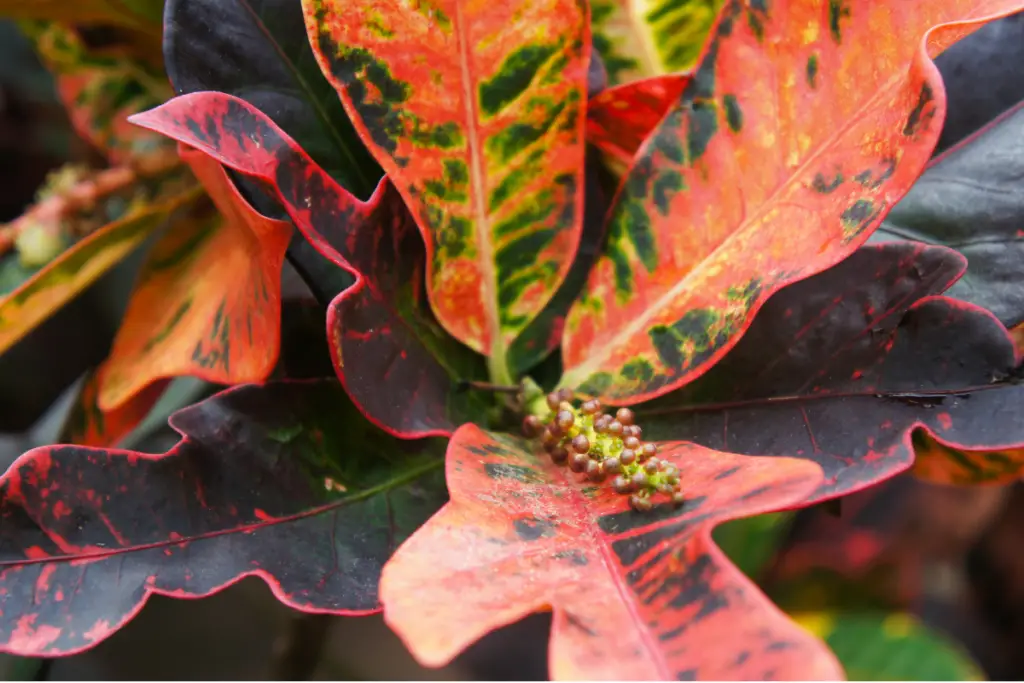Croton Mammy, also known as Codiaeum Variegatum Mamey Croton, is a colorful and vibrant plant that can be a great addition to any indoor or outdoor garden.
This plant is known for its bright and bold foliage, which can range from green to yellow to red.
Growing Croton Mammy can be a rewarding experience, but it requires proper care and attention.
To care for Croton Mammy, it is important to provide it with the right amount of light, water, and nutrients.
This plant thrives in bright, indirect light, so it should be placed near a window that receives plenty of sunlight. However, direct sunlight can cause the leaves to scorch, so it is important to avoid placing the plant in direct sunlight.
Croton Mammy also needs to be watered regularly, but it is important to avoid overwatering as this can cause root rot.
Additionally, providing the plant with the right amount of fertilizer can help it grow strong and healthy.

Table of Contents
Understanding Croton Mammy
Origins and Species
Croton Mammy, also known as Codiaeum variegatum ‘Mammy’, is a tropical plant that is native to Indonesia, Malaysia, and the western Pacific Ocean islands.
It belongs to the family Euphorbiaceae and is related to the poinsettia plant. There are over 100 different species of Croton, each with its own unique leaf shape, size, and color.
The Croton Mammy is one of the most popular cultivars of the species because of its vibrant and colorful foliage.
Distinctive Features
Croton Mammy is an evergreen shrub that can grow up to 6 feet tall. It has thick, leathery leaves that are glossy and twisted.
The leaves can be up to 12 inches long and come in a range of colors, including red, orange, yellow, green, and purple.
The colors can be solid or variegated, and the patterns can be speckled, striped, or blotched.
The leaves of the Croton Mammy are the main attraction of the plant and make it a popular choice for indoor and outdoor decoration.
Croton Mammy requires bright, indirect sunlight and warm temperatures to thrive. It is a low-maintenance plant that requires occasional watering and fertilization. However, it is essential to avoid overwatering and keep the soil moist but not waterlogged.
Croton Mammy is also sensitive to cold temperatures and should be kept away from drafts and air conditioning vents.
With proper care, the Croton Mammy can live for several years and continue to provide vibrant color to any space it occupies.
Ideal Environment for Croton Mammy
Croton Mammy is a colorful plant that requires specific environmental conditions to thrive.
In this section, we will discuss the ideal environment for Croton Mammy, including its light and temperature needs.
Light Requirements
Croton Mammy requires bright but indirect light to grow well. It should be placed in a spot that receives between 10,000 to 20,000 lux of light.
Direct sunlight can cause the leaves to scorch, so it is best to avoid placing it in direct sunlight.
If the plant is not getting enough light, its leaves may turn yellow and drop off. On the other hand, if it is getting too much light, the leaves may develop brown spots or edges.
Temperature Needs
Croton Mammy thrives in warm and humid environments. It prefers temperatures between 60°F to 70°F (15°C to 21°C).
It is not frost-tolerant, so it should be kept indoors during the winter months if you live in a colder climate.
It is important to note that sudden temperature changes can cause the plant to drop its leaves.
Therefore, it is best to keep the plant in a location with a consistent temperature and avoid placing it near drafty windows or doors.
In summary, Croton Mammy needs bright but indirect light and warm and humid temperatures to grow well.
By providing the plant with the right environmental conditions, you can enjoy its colorful foliage for years to come.
Watering and Feeding
Watering Frequency
Croton Mammy prefers to be kept moist, but not overly wet. Over-watering can cause root rot, which can be fatal to the plant.
The best way to water Croton Mammy is to allow the top inch of soil to dry out before watering again. This will prevent water from accumulating at the roots and causing root rot.
It is important to note that tap water can contain chemicals that can damage the plant. It is best to use rainwater or let tap water sit overnight to allow the chemicals to dissipate before watering.
Fertilizer Needs
Croton Mammy benefits from regular fertilization during the growing season. A slow-release granular fertilizer should be applied once in spring, summer, and fall.
This will provide the necessary nutrients for healthy growth and vibrant foliage.
It is important to avoid over-fertilization, as this can cause the leaves to turn brown and fall off. It is recommended to follow the manufacturer’s instructions for application rates and frequency.
In addition to regular fertilization, Croton Mammy can benefit from occasional foliar feeding. This involves spraying a diluted liquid fertilizer directly onto the leaves.
This can help provide a quick boost of nutrients and improve the overall health and appearance of the plant.
Overall, proper watering and fertilization are essential for the health and beauty of Croton Mammy. By following these guidelines, gardeners can ensure their plants thrive and produce stunning foliage year-round.
Pruning and Repotting
When to Prune
Pruning croton mammy is an essential part of its care routine. The best time to prune croton mammy is in the spring or early summer before the growing season begins.
Pruning helps to promote bushier growth and maintain the plant’s shape.
It is also important to remove any dead or damaged leaves and stems to prevent the spread of disease.
Repotting Procedure
Croton mammy requires well-draining soil and a container with good drainage holes. Repotting should be done every two years or when the plant has outgrown its current container.
The best time to repot is in the spring, just before the growing season begins.
To repot, gently remove the plant from its current container and loosen any tangled roots. Place a layer of fresh potting soil in the bottom of the new container and position the plant in the center.
Fill the container with fresh potting soil, leaving about an inch of space at the top. Water the plant thoroughly and place it in a bright, indirect light.
Croton mammy can be sensitive to changes in its environment, so it is important to monitor it closely after repotting.
Avoid fertilizing for the first month after repotting to allow the plant to adjust to its new environment.
Overall, pruning and repotting are important aspects of croton mammy care that help to maintain the plant’s health and appearance.
By following these simple steps, gardeners can enjoy the vibrant colors and unique foliage of this beautiful plant.
Common Problems and Solutions
Croton Mammy is a relatively low-maintenance plant, but it can still experience some issues.
Here are some common problems and their solutions.
Pest Issues
Croton Mammy can be susceptible to pest infestations. Common pests that can affect this plant include spider mites, mealybugs, and scale insects.
If you notice any of these pests on your plant, it’s important to take action quickly to prevent them from spreading.
To get rid of spider mites, you can use a solution of water and dish soap. Simply mix a few drops of dish soap with water in a spray bottle and spray the solution on the affected areas of the plant.
For mealybugs and scale insects, you can use rubbing alcohol on a cotton swab to remove them from the plant.
Disease Concerns
Croton Mammy can also be vulnerable to certain diseases, such as leaf spot and root rot. Leaf spot is a fungal disease that can cause yellow or brown spots on the leaves of the plant.
To prevent this disease, make sure your plant is not overwatered and is receiving adequate air circulation.
Root rot is a common issue that can occur when the plant is overwatered or the soil is not well-draining. To prevent root rot, make sure to allow the soil to dry out between waterings and ensure that the pot has proper drainage.
If you notice any signs of disease on your Croton Mammy, it’s important to take action quickly to prevent it from spreading. Remove any affected leaves or stems and treat the plant with a fungicide if necessary.
Overall, with proper care and attention, Croton Mammy can thrive and remain healthy and vibrant for years to come.
Propagating Croton Mammy
Propagation Methods
Croton Mammy can be propagated through stem cuttings or air layering. Stem cuttings are the easiest and most common method of propagation.
Take a 4-6 inch stem cutting from the tip of the plant. Make sure the cutting has at least 2-3 leaves and a node.
Remove the lower leaves and dip the cut end in rooting hormone powder. Plant the cutting in a pot with well-draining soil and keep it in a warm, bright location.
Keep the soil moist but not waterlogged. The cutting should root in 4-6 weeks.
Air layering is a more advanced method of propagation. This method involves wounding the stem of the plant and wrapping it with moist sphagnum moss and plastic wrap.
Roots will form at the wound site and the plant can be cut off and potted once roots have formed.
Growth Timeline
Once the cutting has rooted, it will take about 2-3 months for the plant to establish itself and start growing.
During this time, it is important to keep the soil moist and provide the plant with bright, indirect light.
After 3 months, the plant should be well-established and can be fertilized with a balanced fertilizer every 2-3 months.
Croton Mammy is a slow-growing plant and may take several years to reach its full size. With proper care and maintenance, the plant can grow up to 6 feet tall and 3 feet wide.
It is important to prune the plant regularly to maintain its shape and encourage new growth.
Propagation is a great way to expand your collection of Croton Mammy plants. With the right care and patience, you can enjoy the colorful foliage of this beautiful plant for years to come.
Conclusion
In conclusion, caring for the colorful Codiaeum Mammy or Croton Mammy is easy as long as you provide it with the right amount of light, water, and nutrients.
With proper care, your Croton Mammy will thrive and add a vibrant touch of color to your indoor or outdoor space.
- How to Dry Basil Leaves: A Professional Guide
- Is an Avocado a Fruit or Vegetable? Simple Answer and Explanation
- Does Pineapple Have Seeds? Exploring the Anatomy of Pineapples
- Blooming Through Winter: Can I Grow Vegetables Indoors in the Winter?
- What Can You Grow in a Greenhouse All Year Round: A Guide to Year-Round Greenhouse Gardening
- Are Blueberries Blue? Debunking the Myth of Their Color
















